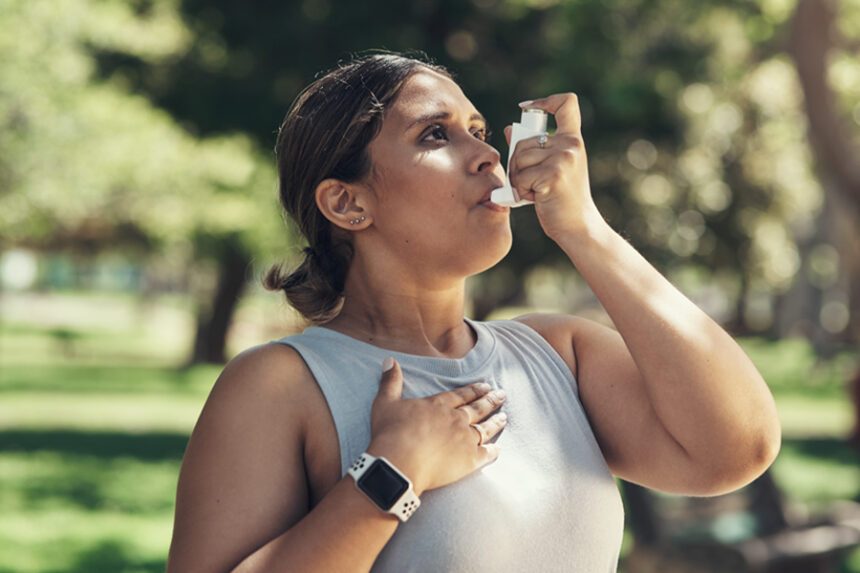When you have asthma and sometimes struggle to breathe, exercise can be intimidating. But for the more than 25 million people in the United States who have asthma, exercise is still necessary for overall health.
Asthma is a lung disease caused by narrow or blocked airways. Most asthma is triggered by viral illness, such as colds or the flu, and it can also be caused by allergies. Most people who have allergy-related asthma also experience exercise-induced asthma, which is coughing, wheezing, chest tightness and shortness of breath during physical activity.
“What we see happen as you start to exercise is that your airways narrow down, and this leads to wheezing and coughing and shortness of breath for people who have asthma,” says Ceila Loughlin, MD, director of the UNC Children’s Allergy & Asthma Center.
Even though exercise may trigger asthma, that does not mean you should avoid exercise. Regular activity can help strengthen your heart and lungs, relieving asthma symptoms.
“Exercise is really important for everyone, and asthma should not limit that,” Dr. Loughlin says. But “you may need to adjust a couple of things in what you do before you start exercising.”
Dr. Loughlin suggests these four tips to exercise safely with asthma:
1. Take your asthma medication.
Medication is one of the best ways to treat an asthma flare-up. This medication is often delivered to your lungs through an inhaler and spacer. Your doctor may prescribe two types of medication to treat your asthma: one for long-term asthma control and one that is used just before exercise or if you need quick relief at the first sign of asthma symptoms. Long-term control medicines reduce inflammation or swelling of the airways over time and are taken daily. Quick-relief medicines relax and open your airways at the first sign of asthma symptoms and are used as needed.
“We recommend using their reliever/rescue inhaler about 15 minutes before exercise,” Dr. Loughlin says. “That helps open up those airways before you even get into the trigger of exercise.”
2. Warm up your lungs and body.
Take about 10 minutes to warm up before working out. This can help ease your lungs into exercise.
“Warm up first rather than go straight into that intense exercise,” Dr. Loughlin says.
For example, increase your heart rate slowly by walking before jogging.
3. Breathe through your nose during workouts.
When you breathe, your nose is supposed to humidify the air you breathe before it reaches your lungs and filter out particles such as dust and allergens.
“What happens when you exercise is that you start to breathe through your mouth and you don’t get that extra humidity, so that dry air aggravates the lungs—especially in the wintertime when it is cold, dry air,” Dr. Loughlin says.
4. If you are having trouble catching your breath, take a break.
Listen to your body and stop exercising if you start to have trouble breathing. Take a few puffs of your inhaler and slow down your pace.
It is really important to educate children about what to do when they feel the symptoms of an asthma flare, Dr. Loughlin says. Be sure to watch for those signs as a parent, coach or teacher.
“A lot of times what we see is kids continuing to play soccer or play basketball and not even realizing that they are getting into trouble,” Dr. Loughlin says. “The adults need to be observing changes in the child’s breathing or energy level during the game so they can help pull them out to take the rescue inhaler if necessary.”
If you have a child with asthma, make sure their gym teachers and coaches know, and that your child has a rescue inhaler and spacer with them in their activity bag.
“We recommend a rescue inhaler kept at home and a rescue inhaler kept at school,” Dr. Loughlin says. “And then a lot of times there’s one that travels with them wherever they’re going to play sports.”
If you or your child continues to have trouble with asthma during exercise, you may need to adjust the long-term asthma control medication.
Adults and children with asthma do not need to be limited in terms of what they can do, Dr. Loughlin says.
“We can find a plan that will work. It just may take some adjustment,” she says. “There are Olympic athletes and professional athletes who have asthma.”
Worried you or your child may have asthma? Talk to your doctor. Need a doctor? Find one near you or learn more about asthma care and treatment for adults and children at UNC Health.

